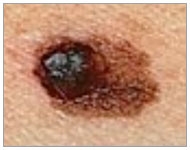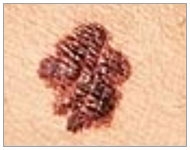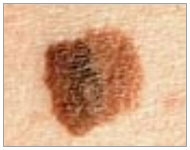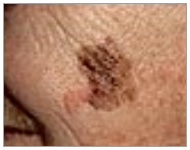
What is Skin Cancer?
Cancer develops when DNA, the molecule found in cells that encodes genetic information, becomes damaged and the body cannot repair the damage. These damaged cells begin to grow and divide uncontrollably. When this occurs in the skin, skin cancer develops. As the damaged cells multiply, they form a tumor. Three types of skin cancer account for nearly all diagnosed cases. Each of these three cancers begins in a different type of cell within the skin, and each cancer is named for the type of cell in which it begins. Skin cancers are divided into one of two classes: non-melanoma skin cancers and melanoma. Melanoma is the deadliest form of skin cancer.
Different types of skin cancer:
-
Basal cell carcinoma (BCC):
The most common cancer in humans, BCC develops in more than 1 million people every year in the United States alone. About 80% of all skin cancers are BCC, a cancer that develops in the basal cells – skin cells located in the lowest layer of the epidermis. BCC can take several forms. It can appear as a shiny translucent or pearly nodule, a sore that continuously heals and then re-opens, a pink slightly elevated growth, reddish irritated patches of skin, or a waxy scar. Most BCCs appear on skin with a history of exposure to the sun, such as the face, ears, scalp, and upper trunk. These tumors tend to grow slowly and can take years to reach ½ inch in size. While these tumors very rarely metastasize (cancer spreads to other parts of the body), dermatologists encourage early diagnosis and treatment to prevent extensive damage to surrounding tissue.
-
Squamous cell carcinoma (SCC):
About 16% of diagnosed skin cancers are SCC. This cancer begins in the squamous cells, which are found in the upper layer of the epidermis. About 200,000 cases are diagnosed ever year. SCC tends to develop in fair-skinned middle-aged and elderly people who have had long-term sun exposure. It most often appears as a crusted or scaly area of skin with a red inflamed base that resembles a growing tumor, non-healing ulcer, or crusted-over patch of skin. While most commonly found on sun-exposed areas of the body, it can develop anywhere, including the inside of the mouth and the genitalia. SCC may arise from actinic keratoses, which are dry, scaly lesions that may be skin-colored, reddish-brown or yellowish-black. SCC requires early treatment to prevent metastasis (spreading).
-
Melanoma:
Accounting for about 4% of all diagnosed skin cancers, melanoma begins in the melanocytes, cells within the epidermis that give skin its color. Melanoma has been coined “the most lethal form of skin cancer” because it can rapidly spread to the lymph system and internal organs. In the United States alone, approximately one person dies from melanoma every hour. Older Caucasian men have the highest mortality rate. Dermatologists believe this is due to the fact that they are less likely to heed the early warning signs. With early detection and proper treatment, the cure rate for melanoma is about 95%. Once its spreads, the prognosis is poor. Melanoma sometimes develops in a pre-existing mole or looks like a new mole, which is why it is important for people to know what their moles look like and be able to detect changes to existing moles and spot new moles.
Causes:
Sun exposure is the leading cause of skin cancer. According to the American Cancer Society, “Many of the more than 1 million skin cancers diagnosed each year could be prevented with protection from the sun’s rays.” Scientists now know that exposure to the sun’s ultraviolet (UV) rays damages DNA in the skin. The body can usually repair this damage before gene mutations occur and cancer develops. When a person’s body cannot repair the damaged DNA, which can occur with cumulative sun exposure, cancer develops. In some cases, skin cancer is an inherited condition. Between 5% and 10% of melanomas develop in people with a family history of melanoma.
Who Gets Skin Cancer?
Skin cancer develops in people of all colors, from the palest to the darkest. However, skin cancer is most likely to occur in those who have fair skin, light-colored eyes, blonde or red hair, a tendency to burn or freckle when exposed to the sun, and a history of sun exposure. Anyone with a family history of skin cancer also has an increased risk of developing skin cancer. In dark-skinned individuals, melanoma most often develops on non-sun-exposed areas, such as the foot, underneath nails, and on the mucous membranes of the mouth, nasal passages, or genitals. Those with fair skin also can have melanoma develop in these areas.
Skin Cancer Rates Are Rising
While Americans now recognize that overexposure to the sun is unhealthy, the fact remains that most do not protect their skin from the sun’s harmful rays. As a result, skin cancer is common in the United States. More than 1 million nonmelanoma skin cancers are diagnosed each year, and approximately one person dies from melanoma every hour. If current trends continue, 1 in 5 Americans will develop skin cancer during their lifetime. Melanoma continues to rise at an alarming rate. In 1930, 1 in 5,000 Americans was likely to develop melanoma during their lifetime. By 2004, this ratio jumped to 1 in 65. Today, melanoma is the second most common cancer in women aged 20 to 29.
Prevention and Early Detection Key
Sun protection can significantly decrease a person’s risk of developing skin cancer. Sun protection practices include staying out of the sun between 10 a.m. and 4 p.m. when the rays are strongest, applying a broad-spectrum (offers UVA and UVB protection) sunscreen with a Sun Protection Factor (SPF) of 30 or higher year-round to all exposed skin, and wearing a protective clothing, such as a wide-brimmed hat and sunglasses when outdoors. Since skin cancer is so prevalent today, dermatologists also recommend that everyone learn how to recognize the signs of skin cancer, use this knowledge to perform regular examinations of their skin, and see a dermatologist annually (more frequently if at high risk) for an exam. Skin cancer is highly curable with early detection and proper treatment.
Skin Cancer Screenings and Diagnosis
Board-certified dermatologist Dr. Ross Kaplan offers skin cancer screenings at Coastal Dermatology. Regular self-examinations of your skin are key to early detection of skin cancer. If you have never examined your skin for cancer, getting a skin cancer screening can be helpful. During the examination, you will be checked for signs of skin cancer and taught how to examine your own skin. Please contact us to schedule your skin cancer screening.
Melanoma Detection – ABCD
A – Asymmetry: Different on each side

B – Border: Irregular

C – Color: Multiple colors

D – Diameter – Greater than 6mm

